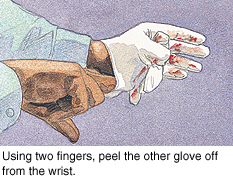Bloodborne Pathogens: After an Accident
Bloodborne Pathogens: After an Accident
Whether or not housekeeping is a regular part of your job, at some time you might be involved in cleaning up after an accident. Proper cleaning of the accident site keeps blood or body fluids away from yourself and others.
| |
|
|
Step 1. Clean it safely
-
Wear protective gloves. Also wear eye and face protection if splashes could occur.
-
To destroy dangerous germs, use disposable towels soaked in an approved disinfectant.
-
Dispose of the towels in properly labeled biohazard bags or containers.
Step 2. Remove your personal protective equipment (PPE) carefully
-
Take off clothing by carefully peeling it away from your body.
-
Put the clothing in a biohazard bag for proper disposal or cleaning.
-
Remove your gloves by following the steps on this sheet.
-
Dispose of your gloves in a biohazard bag. Do not throw them in the regular garbage.
-
Always wash your hands well after removing PPE.
Step 3. Wash thoroughly
-
Wash your hands, wrists, and forearms right away after helping or cleaning up. Wash well with soap and running water. Work up a good lather. Get between your fingers and around and under your nails. Wash for at least 20 seconds. Then rinse well and dry your hands.
-
If blood or body fluids have splashed in your eyes, wash them out thoroughly at an eyewashing station. You will need to follow your employer's plan for exposure to bloodborne pathogens.
-
If blood or body fluids have splashed or gotten on your hair or clothes, wash your whole body.
Updated:
January 23, 2020
Sources:
Kuhar, DT, Guidelines for the Management of Occupational Exposures to HIV and Recommendations for Postexposure Prophylaxis, Infection Control and HOspital Epidemiology (2013); 34(9); pp. 875-892
Reviewed By:
Horowitz, Diane, MD,Sather, Rita, RN


